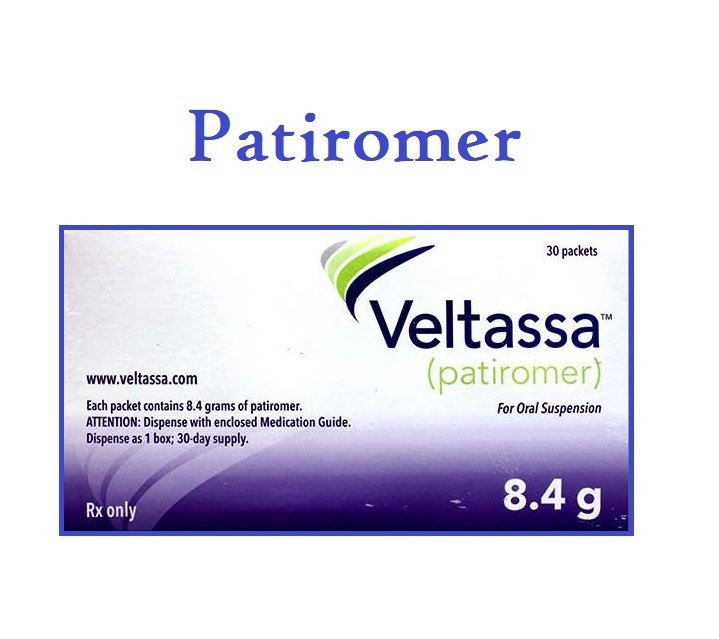Patiromer MOA is similar to Sodium Zirconium Cyclosilicate (Lokelma) and Sodium Polystyrene sulfonate (SPS, Kayexalate). These remove the excess potassium from the body.
Patiromer (Veltassa), Sodium Zirconium Cyclosilicate (Lokelma), and Sodium Polystyrene Sulfonate (Kayexalate) are the three potassium binding resins that have a slightly different mechanism of action (MOA), however, all of them bind to the ingested potassium and results in the excretion of potassium through the gastrointestinal tract.
Patiromer MOA (Mechanism of action):
Patiromer (Veltassa) is a cation exchange resin that does not get absorbed via the gastrointestinal tract. It contains a calcium-sorbitol counterion that exchanges potassium for calcium and removes excess potassium from the GI tract especially in the distal colon. It also removes magnesium from the body and may result in severe magnesium deficiency.
Sodium zirconium cyclosilicate is also a novel potassium binding resin that removes the body of excess potassium in exchange for hydrogen and sodium ions. Sodium Polystyrene sulfonate or kayexalate removes potassium by exchanging potassium and sodium ions resulting in the excretion of potassium from the body.
Patiromer (Veltassa) and Sodium Zirconium Cyclosilicate (Lokelma) in the treatment of Hyperkalemia:
Hyperkalemia is life-threatening especially in acute emergency settings and needs urgent treatment. Most patients who have hyperkalemia in emergency settings require treatment like Calcium gluconate, Sodium Bicarbonate, Beta-agonists, Insulin-Dextrose, and in some cases, hemodialysis to rapidly reduce the plasma levels of potassium.
However, except for hemodialysis, all these treatments only result in potassium shifting from the extracellular compartment to the intracellular compartment. They do not cause the excess potassium from getting removed from the body. For long-term treatment, potassium binding resins such as Patirmer (Veltassa), Sodium Zirconium Cyclosilicate (Lokelma), and SPS or Kayexalate should be used.
Where available Patiromer (Veltassa) and Sodium Zirconium Cyclosilicate (Lokelma) are the preferred therapies as these are more effective and least likely to be associated with adverse events. In patients who have life-threatening hyperkalemia, Patiromer and Sodium Zirconium Cyclosilicate may be used in emergency settings as well.
The onset of action of Patiromer is about 7 hours and that of Sodium Zirconium Cyclosilicate (Lokelma) is about 1 hour.
Patiromer (Veltassa), Sodium Zirconium Cyclosilicate (Lokelma), and SPS (Kayexalate) in the treatment of HYperkalemia:
When using a cation exchange resin, especially in a hyperkalemic emergency, it is recommended to use Patiromer or Sodium Zirconium Cyclosilicate (Lokelma).
Patiromer is administered orally or via a nasogastric tube in a dose of 8.4 gm once daily. The dose may be repeated at weekly intervals by 8.4 gms to the maximum dose of 25.2 gms (three times the initial dose) until the levels are maintained in stale ranges.
Patiromer dose: 8.4 gms once daily
Sodium Zirconium Cyclosilicate (Lokelma) is administered in a dose of 10 grams three times a day for at least two days. The dose is then reduced and the maintenance dose is given in a range of 5 to 15 mg once daily.
Sodium Zirconium Cyclosilicate (Lokelma) Dose: 10 gms thrice daily for 48 hours
Preferably these two drugs should be used rather than SPS. These two drugs can reduce the serum potassium level and the effect can be seen within 1 hour of administration with Sodium Zirconium Cyclosilicate (Lokelma). A reduction in serum potassium of about 0.7 mEq/L was seen after 4 hours of the administration of Sodium Zirconium Cyclosilicate (Lokelma) in a dose of 10 grams.
Sodium Zirconium Cyclosilicate (Lokelma) Reduces the Serum Potassium by 0.7 mEq/L after 4 hours
In situations where Patiromer (Veltassa) and Sodium Zirconium Cyclosilicate (Lokelma) is not available SPS can be used in emergency settings as well. It is given in a dose of 15 grams to 60 grams every 4-6 hourly and in clinical trials it was seen that after 24 hours, serum total body potassium was reduced by point 0.93 mEq/L when given in a typical dose. However, with SPS treatment, patients also develop complications like bowel necrosis. this is the most common complication of sodium polystyrene sulfate (Kayexalate).
Kayexalate Dose: 15 – 60 gms every 4 – 6 hourly
It may be used in situations where the patient has life-threatening hyperkalemia and dialysis is not readily available, the newer cation exchange resins are not available, other therapies used to remove potassium from the body like diuretics have failed to reduce the serum potassium levels, and the restoration of kidney functions have failed. All patients should be observed for new-onset abdominal symptoms and evaluated for bowel necrosis if the patient has developed symptoms.
When to avoid Potassium binding resins (Patiromer, Lokelma, and especially SPS):
The most common adverse events associated with potassium-binding resins is related to the gastrointestinal tract. It is important to note that sodium polystyrene sulfate should be avoided in patients who have got:
- Ileus (intestinal pseudo-obstruction)
- Intestinal obstruction (small or large bowel obstruction)
- Inflammatory bowel disease like ulcerative colitis, Crohn’s Colitis, and inflammatory diarrhea as caused by clostridium difficile colitis
- Patients who have undergone bowel surgery and
- Those who have developed severe constipation secondary to opioids ingestion.
In Summary,
Patiromer (Veltassa), Sodium Zirconium Cyclosilicate (Lokelma), and SPS (Kayexalate) are potassium-binding resins. SPS is associated with bowel necrosis. Alternative and safe potassium-binding resins are Patiromer and Lokelma.
